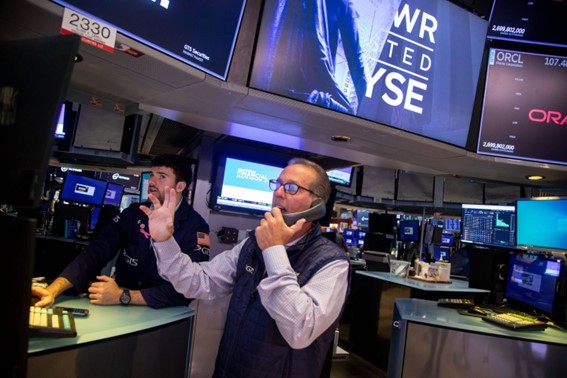
自從OpenAI去年11月推出新聊天機(jī)器人ChatGPT后,,投資者就開始看好人工智能(AI)及其徹底改變世界經(jīng)濟(jì)的潛力。2023年,,隨著AI工具的普及,,人們預(yù)期未來生產(chǎn)率將會提高,而成本將會降低,,因此雖然通脹率居高不下,、利息上揚(yáng)且經(jīng)濟(jì)學(xué)家一致預(yù)測經(jīng)濟(jì)面臨衰退,市場仍然受到了提振,。在2022年下跌逾30%后,,以科技股為主的納斯達(dá)克綜合指數(shù)(Nasdaq Composite)今年迄今上漲了超過28%,,幾乎收復(fù)了所有跌幅,而標(biāo)準(zhǔn)普爾500指數(shù)(S&P 500)目前也上漲了超過12%,。
盡管有些華爾街人質(zhì)疑股市能否在今年下半年保持漲勢——他們指出,,迄今為止引領(lǐng)股市回暖的大型科技公司和AI公司的估值都過高,但是韋德布什證券公司(Wedbush)頂級科技分析師丹·艾夫斯(Dan Ives)認(rèn)為,,現(xiàn)在全球還處在“AI淘金熱”的初期,。
周一,這位資深分析師在一份研究報(bào)告中寫道,,“由于科技公司估值大幅波動,,許多對科技持懷疑態(tài)度的人會把今天比作‘1999年時(shí)刻’(即互聯(lián)網(wǎng)泡沫瀕臨破滅的時(shí)期)。我們強(qiáng)烈反對這一說法,?!薄半m然科技股的估值是一個(gè)需要重點(diǎn)關(guān)注的問題,但我們?nèi)匀幌嘈臕I正在推動科技行業(yè)走向‘1995年時(shí)刻’,,使該行業(yè)在未來很長一段時(shí)間內(nèi)維持1990年代以來從未見過的強(qiáng)勁漲勢,。”
1995年的剛興起的互聯(lián)網(wǎng)熱潮與2023年的AI革命有著極其驚人的相似之處,。無論是當(dāng)時(shí)還是現(xiàn)在,,專家都認(rèn)為,一項(xiàng)新技術(shù)即將重塑全球經(jīng)濟(jì),。那時(shí)候,,股市剛剛結(jié)束慘淡的一年,而且由于美國國債上漲,,經(jīng)濟(jì)學(xué)家和企業(yè)領(lǐng)導(dǎo)者都在為美國的前景感到擔(dān)憂,。像1993年1月出版的《破產(chǎn)1995》(Bankruptcy 1995)這類書成為了上世紀(jì)90年代初的暢銷書,它們都警告稱美國“赤字危機(jī)”導(dǎo)致的經(jīng)濟(jì)崩潰即將來臨——當(dāng)然,,這一刻并未到來,。
盡管市場充滿擔(dān)憂情緒和悲觀預(yù)測,但在1995年至2001年互聯(lián)網(wǎng)泡沫破滅期間,,由于經(jīng)濟(jì)保持穩(wěn)定且投資者希望從互聯(lián)網(wǎng)的崛起中獲利,,納斯達(dá)克綜合指數(shù)仍然飆升了超過800%。在接下來的一年半里,,隨著估值回歸正常水平,,該指數(shù)幾乎回吐了全部漲幅,但值得注意的是,,1995年是互聯(lián)網(wǎng)泡沫的初期,,而不是末期。
艾夫斯認(rèn)為,,我們?nèi)缃窨赡軙吹较嗨频哪J?,并且表示,,AI的發(fā)展標(biāo)志著某種類似于互聯(lián)網(wǎng)革命的東西的到來,他稱之為“第四次工業(yè)革命”,。艾夫斯預(yù)計(jì),,僅在今年下半年,“科技行業(yè)”股票就將再飆升10%至12%,,因?yàn)橥顿Y者將會認(rèn)識到AI對于科技公司來說是一個(gè)“價(jià)值8000億美元的機(jī)會”,,并且這些公司已經(jīng)開始從中獲利。
此外,,艾夫斯還表示,,通脹正在“迅速降溫”,這應(yīng)該會使美聯(lián)儲結(jié)束拖累經(jīng)濟(jì)的連續(xù)大幅加息操作,。美國勞工統(tǒng)計(jì)局的數(shù)據(jù)顯示,,以居民消費(fèi)價(jià)格指數(shù)計(jì)算,同比通脹率已從2022年6月的40年峰值9.1%下降到今年4月的僅4.9%,。該機(jī)構(gòu)將于周二公布5月的數(shù)據(jù),。
艾夫斯指出,如果通脹真的繼續(xù)下跌,,那么投資者應(yīng)該會重燃對能從牛市中獲利的高風(fēng)險(xiǎn)股的興趣,。他寫道,“這表明,,2023年科技股將表現(xiàn)強(qiáng)勁”,,并稱投資者對AI的日益關(guān)注勢必會推動“風(fēng)險(xiǎn)承受交易”。
艾夫斯說,,微軟和英偉達(dá)依然是AI領(lǐng)域“無可爭議的市場引領(lǐng)者”,,但他也認(rèn)為,谷歌,、甲骨文,、亞馬遜、賽富時(shí),、Palantir、MongoDB,、蘋果公司,、IBM、Meta,、Snowflake和C3.ai等科技中堅(jiān)力量,,以及規(guī)模較小的科技公司,也將從技術(shù)的發(fā)展中獲益,。(財(cái)富中文網(wǎng))
譯者:中慧言-劉嘉歡
自從OpenAI去年11月推出新聊天機(jī)器人ChatGPT后,,投資者就開始看好人工智能(AI)及其徹底改變世界經(jīng)濟(jì)的潛力,。2023年,隨著AI工具的普及,,人們預(yù)期未來生產(chǎn)率將會提高,,而成本將會降低,因此雖然通脹率居高不下,、利息上揚(yáng)且經(jīng)濟(jì)學(xué)家一致預(yù)測經(jīng)濟(jì)面臨衰退,,市場仍然受到了提振。在2022年下跌逾30%后,,以科技股為主的納斯達(dá)克綜合指數(shù)(Nasdaq Composite)今年迄今上漲了超過28%,,幾乎收復(fù)了所有跌幅,而標(biāo)準(zhǔn)普爾500指數(shù)(S&P 500)目前也上漲了超過12%,。
盡管有些華爾街人質(zhì)疑股市能否在今年下半年保持漲勢——他們指出,,迄今為止引領(lǐng)股市回暖的大型科技公司和AI公司的估值都過高,但是韋德布什證券公司(Wedbush)頂級科技分析師丹·艾夫斯(Dan Ives)認(rèn)為,,現(xiàn)在全球還處在“AI淘金熱”的初期,。
周一,這位資深分析師在一份研究報(bào)告中寫道,,“由于科技公司估值大幅波動,,許多對科技持懷疑態(tài)度的人會把今天比作‘1999年時(shí)刻’(即互聯(lián)網(wǎng)泡沫瀕臨破滅的時(shí)期)。我們強(qiáng)烈反對這一說法,?!薄半m然科技股的估值是一個(gè)需要重點(diǎn)關(guān)注的問題,但我們?nèi)匀幌嘈臕I正在推動科技行業(yè)走向‘1995年時(shí)刻’,,使該行業(yè)在未來很長一段時(shí)間內(nèi)維持1990年代以來從未見過的強(qiáng)勁漲勢,。”
1995年的剛興起的互聯(lián)網(wǎng)熱潮與2023年的AI革命有著極其驚人的相似之處,。無論是當(dāng)時(shí)還是現(xiàn)在,,專家都認(rèn)為,一項(xiàng)新技術(shù)即將重塑全球經(jīng)濟(jì),。那時(shí)候,,股市剛剛結(jié)束慘淡的一年,而且由于美國國債上漲,,經(jīng)濟(jì)學(xué)家和企業(yè)領(lǐng)導(dǎo)者都在為美國的前景感到擔(dān)憂,。像1993年1月出版的《破產(chǎn)1995》(Bankruptcy 1995)這類書成為了上世紀(jì)90年代初的暢銷書,它們都警告稱美國“赤字危機(jī)”導(dǎo)致的經(jīng)濟(jì)崩潰即將來臨——當(dāng)然,,這一刻并未到來,。
盡管市場充滿擔(dān)憂情緒和悲觀預(yù)測,但在1995年至2001年互聯(lián)網(wǎng)泡沫破滅期間,由于經(jīng)濟(jì)保持穩(wěn)定且投資者希望從互聯(lián)網(wǎng)的崛起中獲利,,納斯達(dá)克綜合指數(shù)仍然飆升了超過800%,。在接下來的一年半里,隨著估值回歸正常水平,,該指數(shù)幾乎回吐了全部漲幅,,但值得注意的是,1995年是互聯(lián)網(wǎng)泡沫的初期,,而不是末期,。
艾夫斯認(rèn)為,我們?nèi)缃窨赡軙吹较嗨频哪J?,并且表示,,AI的發(fā)展標(biāo)志著某種類似于互聯(lián)網(wǎng)革命的東西的到來,他稱之為“第四次工業(yè)革命”,。艾夫斯預(yù)計(jì),,僅在今年下半年,“科技行業(yè)”股票就將再飆升10%至12%,,因?yàn)橥顿Y者將會認(rèn)識到AI對于科技公司來說是一個(gè)“價(jià)值8000億美元的機(jī)會”,,并且這些公司已經(jīng)開始從中獲利。
此外,,艾夫斯還表示,,通脹正在“迅速降溫”,這應(yīng)該會使美聯(lián)儲結(jié)束拖累經(jīng)濟(jì)的連續(xù)大幅加息操作,。美國勞工統(tǒng)計(jì)局的數(shù)據(jù)顯示,,以居民消費(fèi)價(jià)格指數(shù)計(jì)算,同比通脹率已從2022年6月的40年峰值9.1%下降到今年4月的僅4.9%,。該機(jī)構(gòu)將于周二公布5月的數(shù)據(jù),。
艾夫斯指出,如果通脹真的繼續(xù)下跌,,那么投資者應(yīng)該會重燃對能從牛市中獲利的高風(fēng)險(xiǎn)股的興趣,。他寫道,“這表明,,2023年科技股將表現(xiàn)強(qiáng)勁”,,并稱投資者對AI的日益關(guān)注勢必會推動“風(fēng)險(xiǎn)承受交易”。
艾夫斯說,,微軟和英偉達(dá)依然是AI領(lǐng)域“無可爭議的市場引領(lǐng)者”,,但他也認(rèn)為,谷歌,、甲骨文、亞馬遜、賽富時(shí),、Palantir,、MongoDB、蘋果公司,、IBM,、Meta、Snowflake和C3.ai等科技中堅(jiān)力量,,以及規(guī)模較小的科技公司,,也將從技術(shù)的發(fā)展中獲益。(財(cái)富中文網(wǎng))
譯者:中慧言-劉嘉歡
Ever since the release of OpenAI’s new chatbot ChatGPT in November, investors have been enamored with A.I. and its potential to revolutionize the world’s economy. Hopes for a future with increased productivity and lower costs as A.I. tools are rolled out to the masses have helped to lift markets in 2023 despite stubborn inflation, rising interest rates, and consistent recession predictions from economists. After dropping more than 30% in 2022, the tech-heavy Nasdaq Composite has recovered nearly all of its losses, gaining over 28% year to date, and the S&P 500 is now up more than 12%.
While some on Wall Street question whether stocks can continue their run of form in the second half of the year, pointing to stretched valuations in the Big Tech names and A.I. plays that have led the rebound so far, Wedbush’s top tech analyst Dan Ives argues it’s just the beginning of the “A.I. gold rush.”
“Many of the tech skeptics will point to today as a ‘1999 moment,’ à la on the verge of the dotcom bubble/collapse, given the significant move in tech valuations. We strongly disagree,” the veteran analyst wrote in a Monday research note. “While valuations in tech will be front and center, we continue to believe A.I. is driving the tech sector to a ‘1995 moment’ with a long runway of growth ahead that we have not seen since the 1990s.”
The parallels between the dotcom era that began in 1995 and the A.I. revolution of 2023 are quite striking. Both then and now, experts argued that a new technology was on the verge of rewiring the global economy. Stocks were coming off a down year, and economists and business leaders were worried about the future of the U.S. because of its rising national debt. Books like the January 1993 title Bankruptcy 1995 became bestsellers in the early ’90s, warning of a coming economic crash due to America’s “deficit crisis”—which, of course, never came.
Despite the fears and pessimistic predictions, between 1995 and the collapse of the dotcom bubble in 2001, the Nasdaq Composite rose over 800% as the economy remained stable and investors looked to profit from the rise of the internet. Over the following year and half, the index gave back nearly all of those gains when valuations came back to earth, but 1995 was the start of the bubble, not the end.
Ives believes that we could be seeing a similar pattern now, arguing the development of A.I. represents something akin to the internet, calling it the “4th Industrial Revolution.” He predicts the “tech sector” stocks will soar another 10% to 12% in the second half of the year alone as investors recognize that A.I. is an “$800 billion opportunity” for tech firms, and monetization has already begun.
On top of that, he argued that inflation is “rapidly cooling,” which should enable the Federal Reserve to end its streak of aggressive interest rate hikes that have weighed on the economy. As measured by the consumer price index, year-over-year inflation dropped from its June 2022 four-decade high of 9.1% to just 4.9% in April, according to the U.S. Bureau of Labor Statistics. The agency will release May’s data on Tuesday.
If inflation does continue to fall, it should lead investors back into riskier stocks that can benefit from a bull market, according to Ives. “This speaks to a strong year for tech stocks in 2023,” he wrote, arguing the “risk-on trade” will gain momentum as investors focus on the A.I.
Ives said that Microsoft and Nvidia remain the “clear market leaders” in A.I., but he also believes Google, Oracle, Amazon, Salesforce, Palantir, MongoDB, Apple, IBM, Meta, Snowflake, C3.ai, and other tech stalwarts, along with smaller players in the industry, will benefit as the technology advances.






